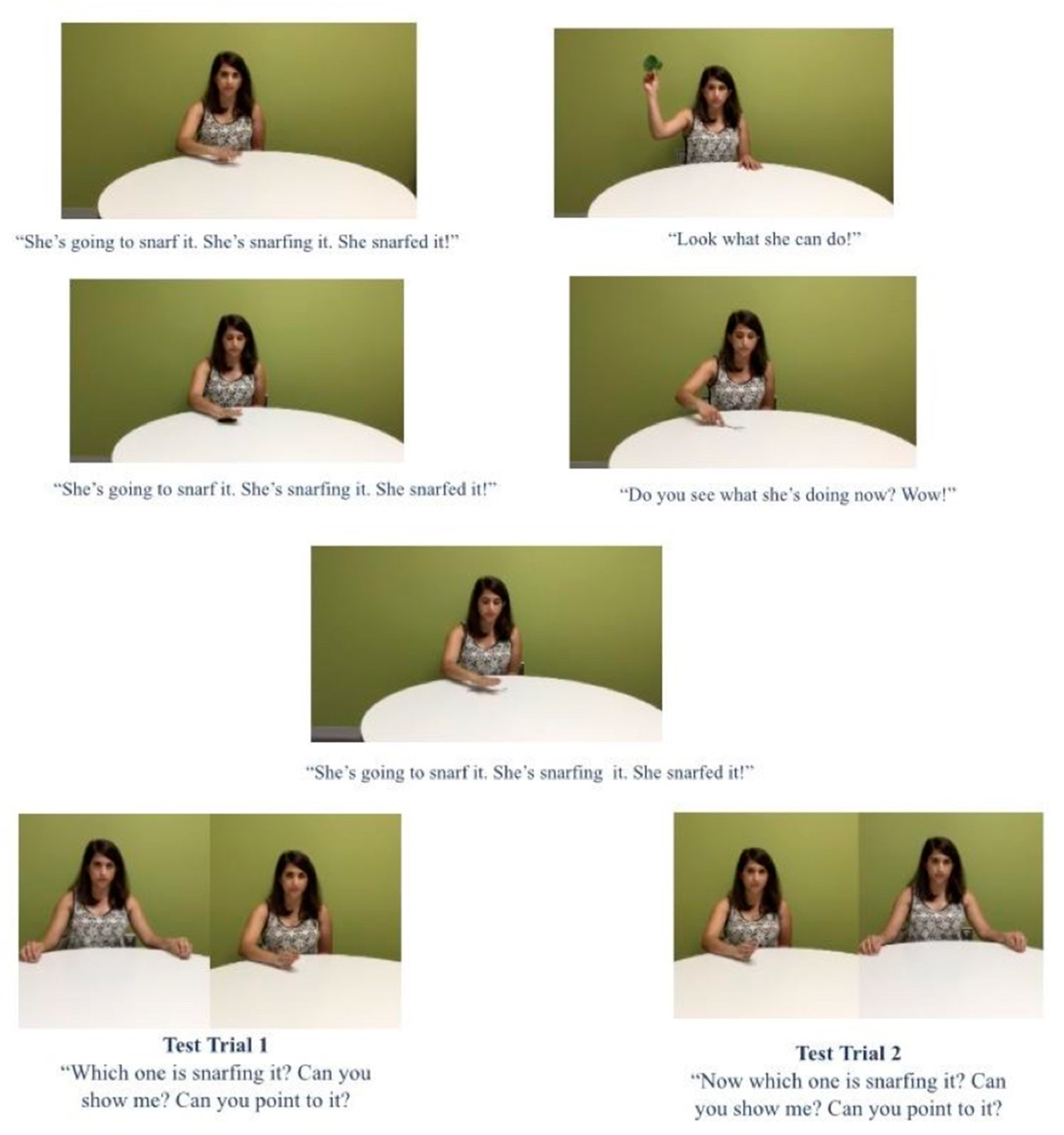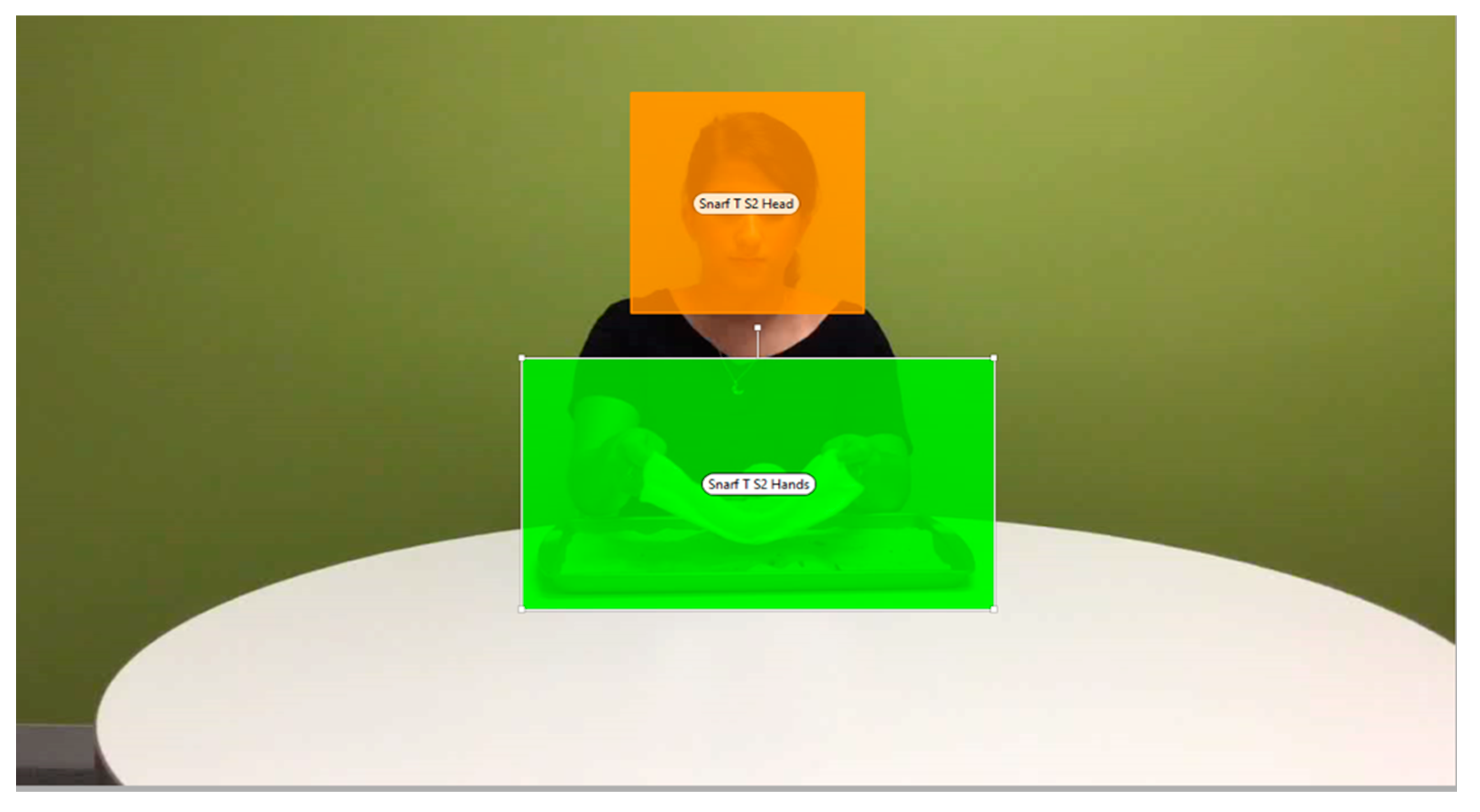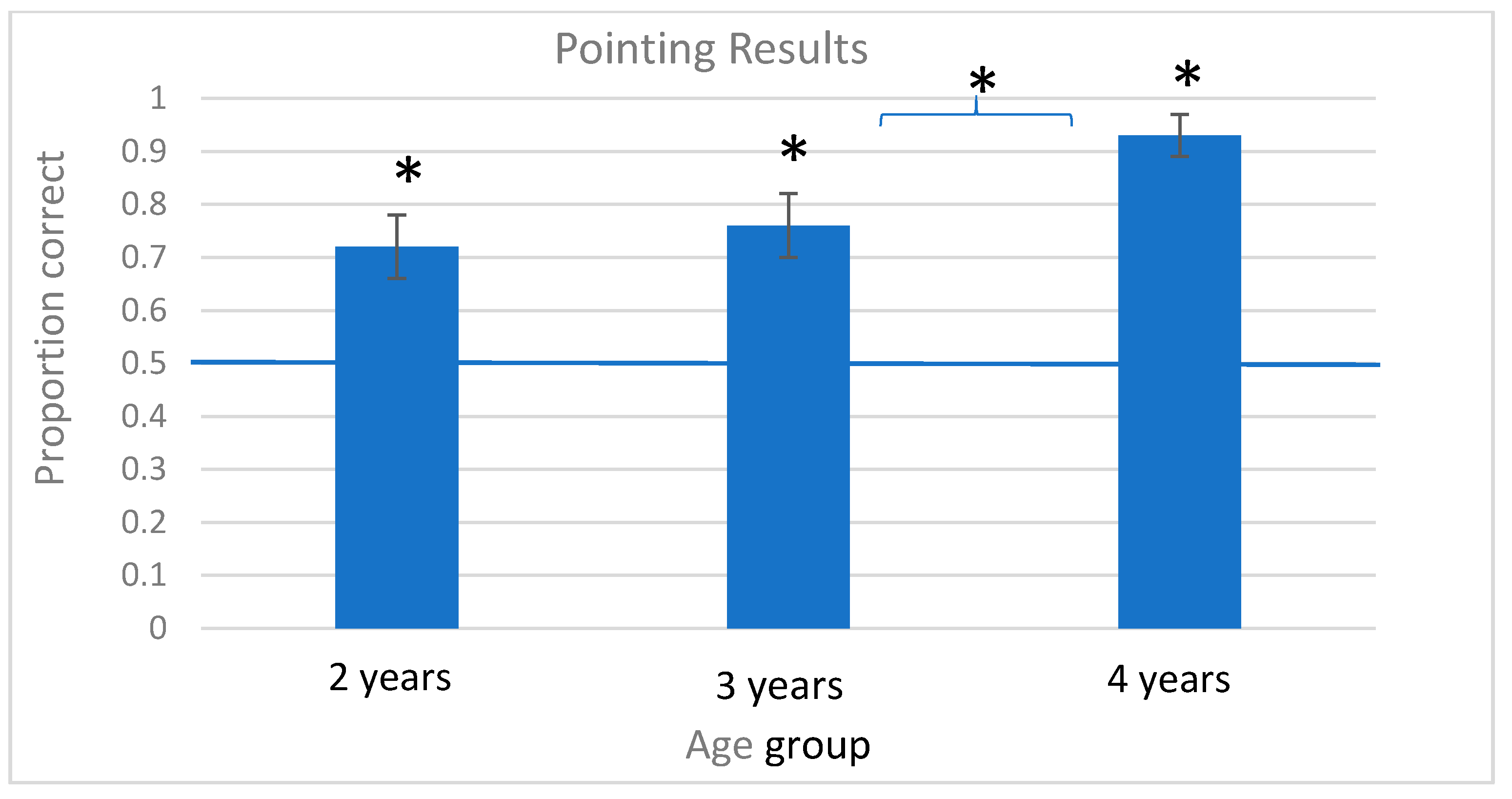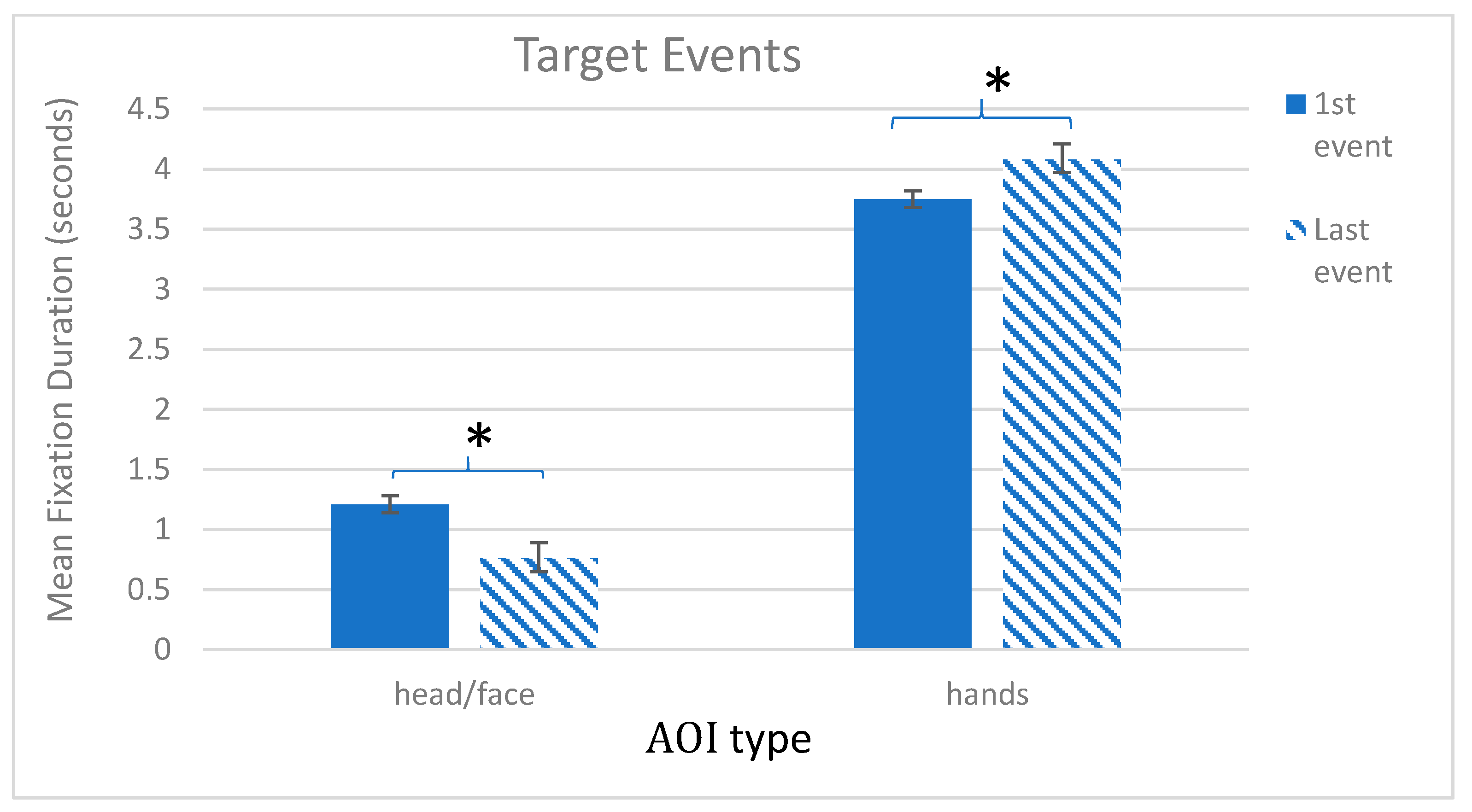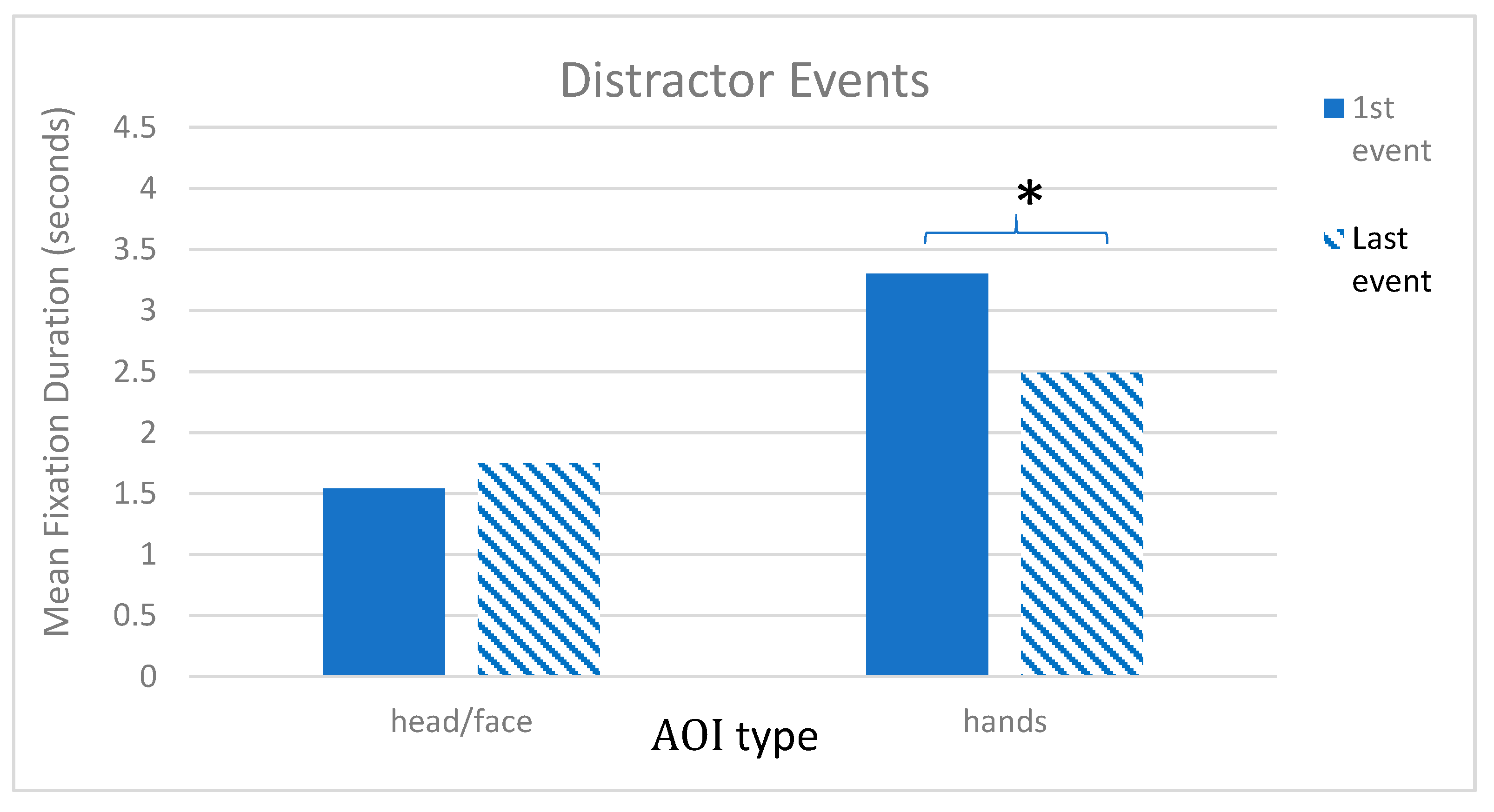1. Introduction
Verbs are central to the syntactic structure of sentences. A controversy in this area is whether children focus on the agent of the action or the action being performed, and to what extent they focus on each one. Some studies suggest that young children learn verbs best when a single agent is seen, which could mean that they are attending too much to agents rather than the actions while learning verbs [
1,
2]. In other studies, children seem to be attending to actions [
3] or results, e.g., [
4,
5]. Additionally, in everyday contexts, children often see events linked to a new verb that are interspersed with distracting events. Yet most laboratory studies of verb learning show children relevant events as they hear the new verb. The present study is important because few studies have tracked children’s looking patterns during verb learning, and few studies have included distracting interleaved events. By tracking looking to target and distractor events, these results will reveal whether children adjust their visual attention to agents (faces) or their actions (hands) differently depending on whether the event is linked to a new verb, which is important for understanding how they may be processing events during verb learning.
To accurately acquire a verb, learners must solve what Gleitman and Gleitman [
6] described as the “packaging problem”, wherein learners must package together only the relevant aspects of a dynamic event and disregard any irrelevant information. Given the difficulty of this problem, learners often use information across events and sentences or engage in cross-situational learning, e.g., [
7,
8,
9,
10]. Research has shown that the comparison of events can help children learn and generalize verbs, e.g., [
3,
11,
12,
13,
14]. Additionally, children can benefit from seeing similar or varied events, depending on the nature of the task and test conditions [
5,
11,
12,
15,
16]. In light of this prior research, it seems clear that young children can glean information across a set of events as they learn verbs, but theories differ in the mechanisms they posit that underlie this cross-situational processing.
Two key theories in this area are statistical learning and structural alignment. In statistical learning, observers compare events by noting co-occurrences between specific words and referents, e.g., [
17,
18,
19]. In structural alignment, observers compare events linked to a new verb over instances by aligning elements across the instances based on their common relational structure, e.g., [
20,
21,
22]. Our study tests whether children’s looking at target and distracting events during the learning phase differs in terms of their focus on agents (faces) or actions (hands). By including both types of trials, we can ask whether there are general looking preferences (e.g., for faces or hands) or whether children attend to events differently when viewing events linked to verbs vs. distracting events. To our knowledge, no prior study verb has used eye tracking in this way, though Scott and Fisher, in 2012 [
3], showed that 2 ½-year-olds could track which whole event was linked to a specific verb over trials.
The present research is related to a recent set of studies in which we showed 2- to 4-year-old children the same events as those used in the present study (without an eye tracker) [
23]. Children were assigned to different orders of events. In all orders, they saw five events during a learning phase; three were target events and two were distractor events. When tested in a forced choice task, children as young as 2 ½ years were able to extend the new verb, demonstrating an ability to distinguish between target and distractor events. However, without an eye tracker, we only have indirect evidence of children’s ability to ignore distracting events. Although this eye tracking study builds on a prior study conducted with an iPad [
23], that prior study used complex, naturalistic backgrounds in the video stimuli, including a park and a kitchen scene. To reduce the visual clutter for the eye tracking study, we re-filmed the events against a plain colored wall. Additionally, the iPad screen used in the prior study was smaller than the large monitor linked to the eye tracker used for this study.
We used a Tobii x30 eye tracker to track children’s looking during the learning phase to the agents’ head/face vs. their hands within each event. As no prior study has tracked looking to the face vs. hands, we hypothesized that children would look more to the hands as the hands AOI (area of interest) is larger (in our stimuli and in everyday life) than the face AOI, and the hands are moving. However, two prior studies demonstrate that children can also be overly attentive to the agent in an event, performing fewer verb extensions in events with multiple agents [
2], particularly when events were more complex [
1]. Given that these two studies suggest a cost from attending to agents, it could be that children will attend more to the face/head of an agent than to the hands during verb learning. Attending more to the hands would help in verb learning while attending to the face would not.
Thus, in the study we used the eye tracker to ask whether children focused more on the face/head or the hands while seeing events in the learning phase, and whether this differed depending on whether the event was linked to a new verb (target) or was not (distractor). We also asked whether they could extend the new verbs at test.
3. Materials
Video stimuli were created showing female actors performing three target scenes showing a single causative action and two distinct distractor actions for each of two novel verbs (see
Figure 1). For the test scenes, a new target scene and a new distractor scene were also filmed.
Specifically, two sets of videos were filmed in which actors used their hands/bodies or tools to enact events that could be done in a park (see
Appendix A). For example, in one set (Park 1), an actor picks up a natural object so that it sticks to an open hand (picking up a leaf, a stick, and a rock in the target events), and waves a leaf around and twirls a stick on the table using her finger in the two distractor events. At test, children saw her pick up an object using an open hand (correct) or move an object from the center to the sides of the table (incorrect). A second event set from this park setting (Park 2) showed the novel target event of sifting objects using a porous flat object to sift sand (target events showed different porous objects and included rocks instead of sand); distractor events showed the agent throwing a rock into the air and tapping two sticks together. At test, children saw the agent wave a sticky note in the air (incorrect) or sift a new object (correct).
There were also two events from a kitchen context. In one set, an actor uses her finger to trace a pattern into oatmeal, into chocolate frosting, and into rice in the three target events (Kitchen 1), and she scoops up oatmeal with her hands and wipes chocolate off her finger onto the side of a container in the two distractor events. At test, she is seen using her finger to trace a pattern into ketchup (correct) vs. holding a ketchup bottle and squirting ketchup into the tray (incorrect). A second kitchen-related set of events (Kitchen 2) was also filmed with the same structure (target event, dunking different objects into a bowl of liquid using different tools); distractor events showed the agent removing a paper towel from a roll and dipping a towel into an empty container. At test, children saw a new dipping action (correct) and saw the agent crushing a cracker using tongs (incorrect).
A three second black screen was inserted between each of the events both during the learning and test phases. A script was created so that for each scene, an experimenter would direct attention to the target actions by saying “Look! She’s going to <novel verb> it. She’s <novel verb>-ing it! She <novel verb>-ed it!”, while using non-labeling speech for the distractor events (e.g., “Oh, look what she is doing!”).
Areas of Interest (AOIs) were drawn by hand using Tobii Studio, with separate AOIs drawn around the head/face region and the hands region for each scene (see
Figure 2).
In addition, because we initially conducted a study using similar stimuli (with cluttered backgrounds) on an iPad, when we reviewed the scenes that were distractor scenes and target scenes for each verb for this eye tracking study, we found that the scenes differed in length. As we wanted to compare distractor to target scenes, we manually adjusted the activation window for each scene to be equivalent across the two types of scenes. Although it would have been better to edit the scenes to be exactly the same length, by adjusting the activation window in the Tobii Studio software for each event, we ensured that the tracker recorded children’s looking for the same amount of time in the distractor and target scenes.
5. Procedure
After building rapport with the children at their childcare center, children whose parents had returned a signed consent form were taken to a quiet room. Children sat in front of a 21-inch flat screen video monitor. A Tobii X30 eye tracker device was placed on the bottom edge of the monitor and was connected to a laptop. Attached to the top of the monitor was a webcam that recorded the children’s pointing responses for later coding. The distance between the table holding the video screen and tracker and the participant’s chair was approximately 16 inches, with some variation to maximize an individual participant’s calibration. The eye tracker used a corneal reflectance tracking technique to measure eye movements. A near infrared light source was directed at the participant, undetectable to the naked eye, and the reflection of the light on the cornea was recorded as the participant watched the video stimulus on a monitor. After being seated in front of the video monitor, the experimenter calibrated the Tobii X30 eye-tracker using the Tobii 5 point calibration stimuli for infants; the software used throughout was Tobii Studio.
Two experimenters were present: one controlled the eye tracker using a laptop and used a script to produce the stimulus sentences, and the other coded children’s pointing using a score sheet. A recording of the session was captured using a webcam mounted above the 21-inch flat screen video monitor for later coding of the pointing responses from video.
Participants were first shown two warm-up trials in which they were asked to point to a familiar event out of two possible events. In one warm-up, children were asked to point to one of two static objects: while seeing a bunch of grapes (left) and a toy teapot (right) they were asked to point to the grapes (“Can you point to the grapes?”). The pair was shown again with the side of the correct match reversed and the question was repeated (“Now look. Where are the grapes now?”). They were then asked to point to one of two dynamic events: a hand pouring pretend liquid into a cup (left) vs. a hand making a cow walk (right); they heard “Can you point to the cow?” and “Where’s the cow now?”.
9. Results
9.1. Pointing Results
A univariate ANOVA with Age group (3: 2 s, 3 s, 4 s) and Order (3: Target first, Distractor first, Alternating) as between subjects factors, dv = proportion trials correct (number correct/total trials with responses), showed that there was a main effect of Age group, F (2, 75) = 3.94, p = 0.024, η2 = 0.11, and an Age group by Order interaction, F (4, 75) = 3.04, p = 0.023, η2 = 0.15. Given the significant Age group by Order interaction, we split the data by age group and repeated the univariate ANOVA within each age group, following up with one sample t-tests to compare responses to chance (=0.50 correct).
In these univariate ANOVAs within each age group, no significant effects of Order emerged in the 2-year-olds and 4-year-olds data. There was a significant effect of Order in the 3-year-old group, with Order, F (2, 30) = 4.25, p < 0.05, η2 = 0.23; pairwise comparisons with Sidak corrections show that children in the Distractor first (DTTDT) condition were significantly less successful at test than were children in the Alternating condition (TDTDT). As this result was found only in one of the three age groups, it suggests to us that overall, the order of the events did not exert a major effect on children’s pointing responses.
A separate analysis examined whether children’s pointing responses differed from chance. One sample
t-test showed that children in all three age groups exceeded chance. (All
t-tests reported are two-tailed.) Specifically, 2-year-old children’s responses exceeded chance (
Mprop = 0.72, SE = 0.06),
t(23) = 3.40,
p = 0.002, as did 3-year-old children’s (
Mprop = 0.76, SE = 0.06),
t(30) = 4.60,
p < 0.001, and 4-year-old children’s responses (
Mprop = 0.93, SE = 0.04),
t(20) = 12.21,
p < 0.001. Reflecting on this pattern of responses, the 2- and 3-year-olds’ pointing responses are similar to each other, but 4-year-olds appeared to be responding at a significantly higher rate. Indeed, an independent samples
t-test comparing 3-year-olds’ to 4-year-olds’ responses was significant,
t(50) = −2.25,
p = 0.029 (see
Figure 3).
Overall, the pointing results show that children in all age groups learned and extended the new verbs successfully, order of learning events was only important in the 3-year-old age group, and the main developmental change occurred between 3 and 4 years.
9.2. Eye Tracking Results: Looking to the Face vs. the Hands
Before analyzing the looking data, we reviewed the quality of the eye tracking obtained and excluded additional participants which the tracker did not track successfully at least 30% of the time (n = 6). Four participants’ eye movements could be tracked but did not point and are only included in the following eye tracking analyses.
A repeated measures analysis of variance (ANOVA) was computed with Age group (3: 2, 3, 4 years) as the between-subjects factor and Trial type (2: target, distractor), Trial number (2: first, last), and AOI (2: face, hands) as within-subjects factors; dv = total fixation duration (with zeros). This analysis revealed a significant main effect of Trial type, F (1, 67) = 18.78 p < 0.001, ηp2 = 0.22, Trial number, F (1, 67) = 12.96, p < 0.001, ηp= 0.16, and AOI, F (1, 67) = 229.29, p < 0.001, ηp 2 = 0.77; there was no significant main effect of Age. There were also three two-way interactions: Trial type × Age group, F (2, 67) = 4.66, p = 0.013, ηp2 = 0.12, Trial type × Trial number, F (1, 67) = 10.47, p = 0.002, ηp2 = 0.14, and Trial type × AOI, F (1, 67) = 135.49, p < 0.001, ηp2 = 0.67. Finally, there was a three-way interaction of Trial type × Trial number × AOI, F (1, 67) = 27.36, p < 0.001, ηp2 = 0.29. To analyze the three-way interaction, we split the data by Trial type and re-ran the analyses.
A repeated measures ANOVA examining looking during the Target trials revealed no effect of Trial number,
F (1, 69) = 0.91,
ns, but a main effect of AOI,
F (1, 69) = 580.62,
p < 0.001, η
p2 = 0.89, and a significant Trial number × AOI interaction,
F (1, 69) = 30.14,
p < 0.001, η
p2 = 0.30. Pairwise comparisons with Sidak corrections showed that, in both the first and last target events, children looked longer at the hands than the face. Specifically, in the first Target event, looking to hands (
M = 3.75, SE = 0.13) was greater than face (
M = 1.21, SE = 0.07),
p = 0.003 (2 sided), and in the last target event, looking to hands (
M = 4.08, SE = 0.11) was greater than face (
M = 0.76, SE = 0.07),
p < 0.001. Importantly though, across trials, looking to the hands increased,
p = 0.003, while looking to the face significantly decreased,
p < 0.001 (see
Figure 4).
In the distractor events, a different pattern emerged. A repeated measures ANOVA revealed a main effect of trial number,
F (1, 69) = 26.96,
p < 0.001, η
p2 = 0.28, a main effect of AOI,
F (1, 69) = 53.91,
p < 0.001, η
p2 = 0.44, and a trial number × AOI interaction,
F (1, 69) = 14.10,
p < 0.001, η
p2 = 0.17. Pairwise comparisons with Sidak corrections showed that, as in the target trials, during these distractor events, children looked longer at the hands than the face with hands (
M = 3.30; SE = 0.13) greater than face (
M = 1.54; SE = 1.0) in the first distractor event,
p < 0.001 (2 sided), and hands (
M = 2.49; SE = 0.15) greater than face (
M = 1.75; SE = 0.14),
p = 0.004 (2 sided) in the second distractor trials. However, across trials, a different pattern was seen with children’s looking to the hands decreasing,
p < 0.001, while looking to the face was maintained (see
Figure 5).
10. Discussion
These results are the first to show that children visually attend to events that are linked to a new verb differently than they attend to distracting events. This is important because children learning verbs often see other intervening events as they are learning verbs (e.g., seeing a stirring event while learning the verb ‘chop’ in the kitchen), which need to be processed differently than events linked to the target verb. Specifically, across age groups, when viewing target events, children increase their looking to the hand region over trials (where the action is taking place) and decrease their looking to the agents’ face, which is less informative for learning a new verb’s meaning. In contrast, when viewing distracting events, children decrease their looking to hands over trials (i.e., the action) while maintaining their attention to the head/face region. Thus, in the distractor events, they are looking less at what the agent is doing as they see more trials, which should help them ignore those events as they learn a verb, whereas when seeing relevant events, they are increasing their looking to the agent’s actions, which should be helpful for deducing what a new verb means.
These results add to a body of research showing that children can compare events during verb learning, and that comparisons help them extend new verbs, e.g., [
3,
14,
15]. What these results add is evidence that children are adjusting their visual fixations differently as they see events linked to a new verb as opposed to distracting events, suggesting that they are strategic in how they visually inspect events. These new results also add to the few studies that have used eye tracking to study children’s verb learning. They extend the results of Papafragou et al., 2021 [
25], by including novel verbs and focusing on faces and hands, adding to their evidence of children’s attention to manners and paths. They add to the findings of Valleau et al., 2018 [
26], by including tracking to parts of events vs. whole events, and they add to a study from Childers et al., 2016 [
15], that included different types of events. That study tested whether children benefited from seeing similar than varied events as opposed to all varied events and showed that children seeing those similar events first increased their looking to important elements in events (e.g., agents, affected objects), and by age 3, could succeed in extending the new verbs at test only in this similar first condition. They also add to the Childers et al. 2020 [
27] study which showed that children increased their visual attention to object types that varied across a learning set (tools and affected objects); this suggests children noticed which element varied likely because they were comparing elements across the events. Together, these studies [
15,
27] with the present result—showing greater attention to hands, and less attention to faces, only for relevant events—all show different ways children attend to specific elements of events as they learn verbs, which is important.
Specifically, because these results show differing attention to different elements in events, they seem more consistent with the structural alignment view which posits learners attend to individual elements and align those elements across instances, e.g., [
21]. Although statistical learning could also include elements (as it has been shown to work for syllables [
28]), to our knowledge, there is no current empirical evidence for attention to elements within events, or overt description of how children could compute statistics across elements within events during verb learning, within the statistical learning framework.
In terms of pointing responses at test, we found that across ages, children were able to learn these new verbs, pointing successfully to a new event (and not a distractor event) that fit the verb they heard during the learning phase at test. Our pointing results also show an increase in the ability to learn these verbs between the ages of 3 and 4 years. When we compare these results with our prior study with similar events containing cluttered, naturalistic backgrounds shown on a tablet, in both studies, children were able to learn and extend new verbs at test, even though the learning phase included two irrelevant events. In the prior study [
23], 2-year-olds’ responses exceeded chance but also were significantly fewer than 3-year-olds’ responses; in the present study, these age groups performed similarly. This could suggest that 2-year-olds were distracted by the cluttered backgrounds in the earlier study, performing better without those backgrounds in this study. Furthermore, in the prior study, children succeeded in all three orders of events, and this same result was also (largely) found in this study. Thus, the results across the two mediums of stimulus presentation, iPad and eye tracker, converged and the pointing results were replicated. One difference in design was that the prior study included two control conditions, a salience control (test trials only), and a one event condition (one target event than test), and children seeing the comparison events were more successful in extending verbs than were children in the control conditions. As we had already demonstrated these differences, we did not include those control conditions in the present study.
Linking the present study to some basic findings concerning brain development (e.g., [
29]), there is a brain area for processing face-like stimuli (the fusiform face area) which appears to help infants as young as 4 months old to process faces, and which appears to continue to develop during childhood. Given these general facts, it seems likely that this FFA guided our preschool children’s attention to the agent’s head/face during our study. In terms of attention to the hands, a similar area which is close to the FFA, the EBA (extrastriate body area), seems implicated in the visual processing of the human body and can take years to fully develop. Given this pattern of development, our preschoolers likely used the EBA to process the hand movements seen in our events, but may not have had adult-like processing in the EBA given its later development (up to 9–12 years).
Turning to limitations of our study, one limitation is that the agent stayed the same across trials. Thus, children could shift their focus from the face to the hands region as they saw more trials. That they did shift to looking more to the hands during the target events suggests that they recognized that the agent stayed the same. At the same time, when viewing the distractor events, children maintained their attention to the agent (i.e., her face/head) over trials (and decreased their attention to the hands), which is interesting. Future eye tracking studies should vary agents to show what effect varying agents have on children’s visual attention. Given the present results, we predict that children may maintain attention to the agent’s face in both target and distractor events if the agent varies, and, thus, may not be able to focus as efficiently on the agent’s hands in the target events as was seen in these results. This would support prior findings showing a cost for variability of agents in verb learning [
1,
2], and extend them by providing eye tracking evidence for this predicted attention cost.
Another limitation is that in this study, there were multiple cues to whether a scene was relevant or irrelevant for learning a verb. Distractor events were heard with non-labelling speech and depicted actions that differed markedly from relevant events. Therefore, future studies will need to separate these factors in order to understand which factor, or a combination of both, contribute to the participants’ understanding of the event as irrelevant. However, artificially presenting a verb during an irrelevant event or showing sets of irrelevant events that are highly similar to the events linked to the verb being learned could have made this task more confusing, especially for our youngest participants. We also do not know if these results extend beyond learning English, but these strategies for looking would be useful for learning verbs in any language, and, thus, we predict that they should.
11. Conclusions
In conclusion, learning new verbs is important to learning one’s native language. Our study suggests that by 2 ½ years old, children have developed visual strategies for inspecting events that should help them attend to events appropriately when seeing relevant events and hearing verbs (attending more to what the hands are doing than the face) and help them ignore distracting information (as they focus on faces and not hands) when they see distracting events. These are exciting new findings that reveal what mental mechanisms could underlie early verb learning. They also suggest ways to help children who may be experiencing a language delay and, perhaps, are not adjusting their visual attention in helpful ways. By directing their attention, or teaching them strategies for comparing events and ignoring events, therapists may be able to help children learn how to acquire new verbs.
Funding for this research was provided by a grant from the National Institute of Health (2R15 HD044447), the Murchison Scholars Fund, and the support of Trinity University. The project was supported by the Eunice Kennedy Shriver National Institute of Child Health and Human Development, and the content is solely the responsibility of the authors and does not necessarily represent the views of NICHD or NIH. We thank Victoria Bell, Sophia Arriazola, Aidan Burke, Priscilla Tovar-Perez, Hannah Bortz, Katy Capps, and Sophia Rodriguez for their assistance in data collection and coding.
